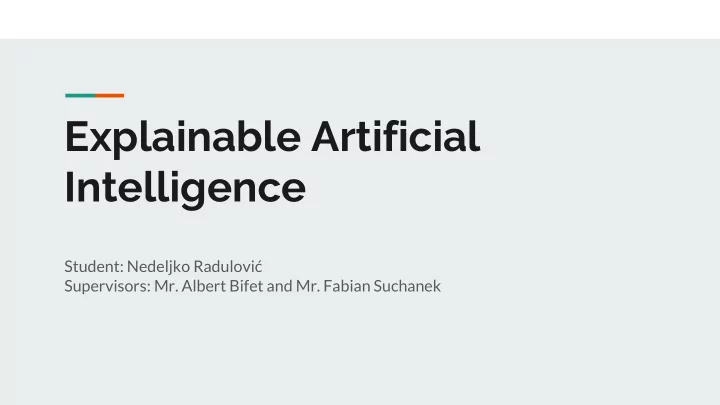

Explainable Artificial Intelligence Student: Nedeljko Radulović Supervisors: Mr. Albert Bifet and Mr. Fabian Suchanek
Introduction
Research avenues Explainability ● Integration of first-order logic and Deep Learning ● Detecting vandalism in Knowledge Bases based on correction history ●
Context Machine Learning and Deep Learning models sometimes exceed the human performance in ● decision making Major drawback is lack of transparency and interpretability ● Bringing transparency to the ML models is a crucial step towards the Explainable Artificial ● Intelligence and its use in very sensitive fields
State of the art Exlplainable Artificial Intelligence is the topic of great ● interest in research in recent years Interpretability: ● Using visualization techniques (mostly used in image and text ○ classification) Explainability: ● Computing influence from inputs to outputs ○ Approximating complex model with a simpler model locally ○ (LIME)
State of the art Attempts to combine Machine Learning and knowledge from Knowledge Bases ● Reasoning over knowledge base embeddings to provide explainable recommendations ○
Explainability
Explainability
Explainability
LIME 1 - Explaining the predictions of any classifier 1: https://arxiv.org/abs/1602.04938
Explaining predictions in streaming setting Idea behind LIME is to use simple models to explain predictions ● Use already interpretable models - Decision trees ● Build Decision tree in the neighbourhood of the example ● Use the paths to leaves to generate explanations ● Use Hoeffding Adaptive Tree in streaming setting and explain how predictions evolve based on ● changes in the tree
Integration of First-order logic and Deep Learning
Integration of FOL and Deep Learning Deep Learning Ultimate goal of Artificial Intelligence: enable machines to think as humans ● Random forest SVM Humans posses some knowledge and are able to reason on top of it ● Logistic regression Reasoning ML Knowledge KBs
Integration of FOL and Deep Learning There are several questions that we want to answer through this research: ● How can KBs be used to inject meaning into complex and uninterpretable models, especially deep neural ○ networks? How can KBs be used more effectively as (additional) input for deep learning models? ○ How we can adjust all these improvements for streaming setting? ○
Main Idea Explore symbiosis of crisp knowledge in Knowledge Bases and sub-symbolic knowledge in Deep ● Neural Networks Approaches that combined crisp logic and soft reasoning: ● Fuzzy logic ○ Markov logic ○ Probabilistic soft logic ○
Fuzzy logic - Fuzzy set
Fuzzy logic - Fuzzy relation and Fuzzy graph close to Chicago Sydney N 0.9 0.1 C New York 0.9 0.1 0.5 L 0.3 0.2 S London 0.5 0.3 0.7 B Beijing 0.2 0.7
Markov Logic and Probabilistic Soft Logic First-order logic as template language ● Example: ● Predicates: friend, spouse, votesFor ○ Rules: ○ friend(Bob, Ann) ⋀ votesFor(Ann,P) → votesFor(Bob, P) spouse(Bob, Ann) ⋀ votesFor(Ann,P) → votesFor(Bob, P)
Markov Logic Add weights to first-order logic rules: ● friend(Bob, Ann) ⋀ votesFor(Ann,P) → votesFor(Bob, P) : [3] spouse(Bob, Ann) ⋀ votesFor(Ann,P) → votesFor(Bob, P) : [8] Interpretation: Every atom ( friend(Bob, Ann), votesFor(Ann,P), votesFor(Bob, P), spouse(Bob, ● Ann) ) is considered as random variable which can be: True or False To calculate probability of an interpretation: ●
Probabilistic Soft Logic Add weights to first-order logic rules: ● friend(Bob, Ann) ⋀ votesFor(Ann,P) → votesFor(Bob, P) : [3] spouse(Bob, Ann) ⋀ votesFor(Ann,P) → votesFor(Bob, P) : [8] Interpretation: Every atom ( friend(Bob, Ann), votesFor(Ann,P), votesFor(Bob, P), spouse(Bob, ● Ann) ) is mapped to soft truth values in range [0, 1] For every rule we compute distance to satisfaction: ● d r (I) = max{0, I(r body ) - I(r head )} Probability density function over I: ●
Detecting vandalism in Knowledge bases based on correction history
Detecting vandalism in KBs based on correction history Collaboration with Thomas Pellissier Tanon ● Based on a paper: “Learning How to Correct a Knowledge Base from Edit History” ● Wikidata project ● Wikidata is a collaborative KB with more than 18000 active contributors ● Huge edit history: over 700 millions edits ● Method uses previous users corrections to infer possible new ones ●
Detecting vandalism in KBs based on correction history Prospective work in this project: ● Release history querying system for external use ○ Try to use external knowledge (Wikipedia articles) to learn to fix more constraints violations ○ Use Machine Learning to suggest new updates ○ Use data stream mining techniques ○
Thank you! Questions, ideas… ?
Research avenues Explainability ● Integration of first-order logic and Deep Learning ● Detecting vandalism in Knowledge Bases based on correction history ●
Recommend
More recommend